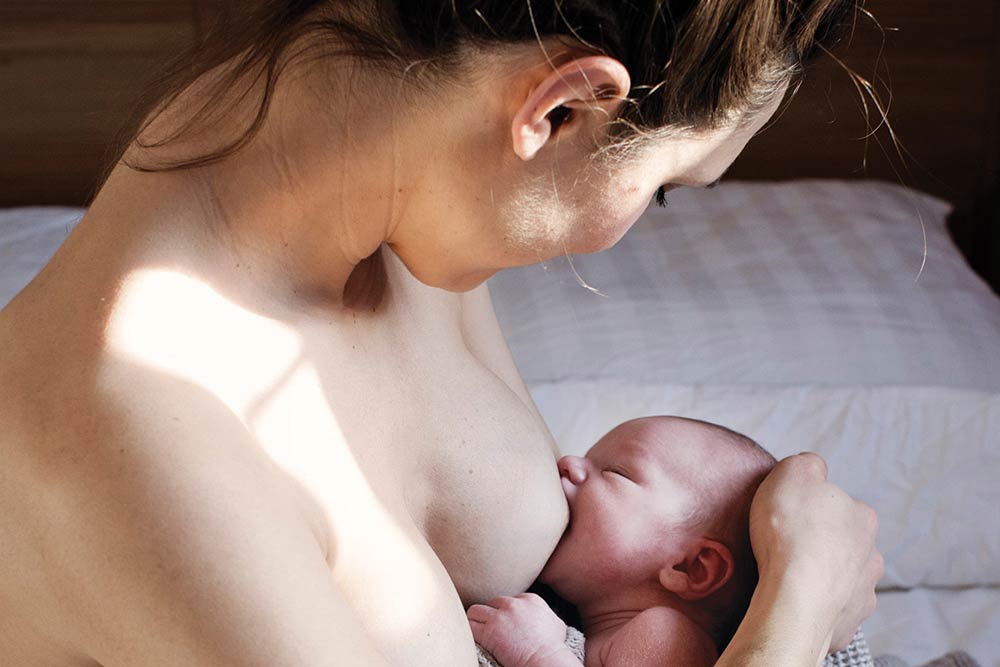Breastfeeding Tips for New Moms

Before my baby was born, I read stacks of articles about breastfeeding. I figured I was prepared for sore nipples, engorgement, constantly leaking breast milk and anything else nursing threw my way—but I couldn’t have been more wrong. Some of the surprises in store were amazing, while others nearly made me give up altogether, which is why I’m here to spill the beans on the wacky and wonderful parts of feeding your baby with your body. So, listen up! Here are the best breastfeeding tips you normally have to learn firsthand …
1 | Nursing is a learning process—for both of you
My prenatal class painted breastfeeding as a completely natural, even mystical, postpartum process. I heard that babies are born with an instinct to do a “breast crawl” to latch on for the first time.
Well, not my baby. I gave birth to my daughter via C-section, so it wasn’t safe for either of us to let her crawl along my torso in the operating room. I nursed her within her first hour, but I needed help from my doctor to figure out what to do. Madeleine was sleepy (understandable—being born is hard work!), and I was worried that my large breasts would smother her or that she wouldn’t be able to nurse from my flat nipples.
Then, Madeleine developed jaundice when she was a day old. This is common, especially for breastfed babies. The doctor on call advised treating her with light therapy. She spent three to four hours under special lamps, came out for 45 minutes to feed, then went back.
It was emotionally difficult to have my baby so close but still out of reach. Feeding her was much harder without ample opportunity to cuddle in between sessions.
By the time we left the hospital, Madeleine was so tired from the jaundice and infrequent feeding that she didn’t have the energy to nurse effectively. Our first night home, I hand-expressed milk into her mouth and bounced her to keep her awake until I was too tired to stand. When my legs gave out, my husband lifted me into a standing position and rocked me and the baby together. That was when we knew we needed to call in an expert.
2 | Getting help can change everything
Although 83 percent of new moms initiate breastfeeding, only 47 percent are still nursing their babies at 3 months, according to the Centers for Disease Control and Prevention (CDC). Only one third are breastfeeding by baby’s first birthday. Lack of adequate support is probably a big factor in that drop. If you struggle to breastfeed in the early weeks, like I did, a lactation consultant can make all the difference.
Ania Gold, IBCLC, works with Metropolitan Breastfeeding, which serves the greater Washington, D.C. area. She’s also connected with La Leche League International (llli.org). Gold worked intensively with me during those arduous first weeks. She wrote up feeding and pumping schedules, taught me to change up breastfeeding positions and how use nipple shields to make latching easier, and offered much-needed encouragement. When I hit bumps at 6 weeks and 3 months, she helped me adapt to my daughter’s changing needs.
My goal was to breastfeed exclusively. Yours doesn’t have to be the same in order to get help from a lactation consultant. The moms Gold sees want to breastfeed as much as their circumstances allow. “For some moms, that’s one bottle of formula per day,” she says. “Sometimes it’s breastfeeding one or two times a day. Every mom and baby are different.”
Don’t be nervous about communicating with a breastfeeding consultant about what feeding success looks like for your family. If a particular expert isn’t comfortable working toward your goals, reach out to another. Working with someone who supports you can make a huge impact on your breastfeeding relationship with your baby.
3 | Every feeding is different
In the early weeks, it can feel like most of a baby’s waking time is spent at the breast. A newborn needs to eat 8 to 12 times a day, but these cluster feeds won’t last forever. The constant suckling and feeling like a human pacifier is nature’s way of ramping up a mother’s milk production, which works on a supply-and-demand system. Baby is just fulfilling the demand part of the equation, so the supply will follow.
The girls aren’t used to all that, ahem, attention, so it’s common to chafe as a result, warns Gold. (Tip: Grab some lanolin!) “It’s a big adjustment, and it’s not something the websites and books tell you. Some babies can breastfeed almost around the clock for those first two weeks. They’re placing the order for mom’s milk to come in and breastfeeding to become well-established.”
The upside is that you get plenty of time to study your baby’s developing personality and get to know their signs of hunger. Every gentle stroke and balled-up fist is a clue to the tiny person you’re getting to know. Bonding with my little one was my favorite breastfeeding benefit. It was satisfying to reinforce the physical connection that we shared, especially because her birth didn’t go as I’d planned. My body continued to support and nourish her, just as it did during pregnancy.
Sometimes our nursing sessions would be quiet and serene; sometimes I broke a sweat wrestling my daughter back into position. On winter nights, she’d tuck her cold fist between my breasts, where it was warmest. It’s totally OK for your baby to show a wide range of behavior at the breast, as long as she’s not hurting you.

4 | Your boobs might feel weird
If you’re a first-time mother, this is likely your first experience producing milk, and breastfeeding will introduce you to your body in an entirely new way.
Many women can feel milk letdown happen. It’s often described as a pins-and- needles sensation, so don’t worry if you suddenly feel like your breast has fallen asleep. That could actually be the ideal time to nurse or use a breast pump.
As your body figures out how much milk your baby needs, you might have to deal with a few other odd or uncomfortable moments. You might leak milk while you’re sleeping—or during sex. Your breasts may get uncomfortably full, making them hard and sensitive.
If you have one hard spot on your breast that hurts to touch, it could be a plugged milk duct. Most of the time, continuing to breastfeed helps clear any clogs. (Tip: Point baby’s chin toward the lump while nursing.) If feeding hurts or you start to feel sick, your doctor or a lactation consultant can help figure out what’s wrong (like possible mastitis) and how best to treat it.
5 | Breastfeeding changes over time
Once you’ve made it through the first few weeks and mastered the cross-cradle hold, you might feel like everything’s going great—that is until your 6-week-old wants to nurse for hours on end and screams when you take him off. Your breasts used to feel firmer before a feed. Now they feel soft and empty all the time. Has your milk supply vanished?
Not necessarily. It’s common for new moms to overproduce milk at first. Your body doesn’t know how strong your baby’s appetite will be. By the 6-week mark, you’ve likely established a rhythm that works for you and your baby. Whether you’re breastfeeding exclusively or doing a mix of nursing and formula-feeding, your body adjusts to produce only the amount of milk it predicts your baby will eat every day.
Meanwhile, your baby is getting stronger and more alert. Infants often go through a fussy period around 6 weeks old. They may also hit a growth spurt. If all this happens at the same time as your body’s natural dip to a “normal” milk supply, look out! I spent three hours nursing my baby girl one afternoon—both of us crying. I wanted to keep breastfeeding her so badly, and I was terrified that she had literally sucked the last drops out of me.
If you’re concerned that your baby isn’t getting enough to eat or experiencing proper weight gain, call a lactation consultant or go to a support meeting for help. Some types of herbal supplements, extra pumping or nursing sessions, and other techniques can boost your supply, if that’s what you need. But don’t rush to diagnose yourself with low milk supply. You might find that after a few days of “cluster feeding” sessions, things return to normal. (Note that if baby doesn’t produce an adequate supply of wet diapers in a day, it’s best to also rope in your pediatrician to be safe.)
6 | Public breastfeeding can be awkward … or empowering
After a few weeks at home, you’ll be ready to rejoin the rest of the world, even if it’s just a trip to Target. Adding an outing to your schedule will mean figuring out how to handle feeding outside the home—because there’s no telling when a wee one’s hunger will strike.
The good news about public breastfeeding: You are in the right. In every part of the country, public breastfeeding is legally protected. You are not obligated to cover up, nurse in a bathroom or leave if someone objects to you nursing.
Still, a lot of new mothers feel nervous or awkward at the prospect of breastfeeding in public. Many of us grew up hearing that breasts are private, and no one wants to be harassed. But there are a few things you can do to feel more at ease with public feedings.
“Practice is the single best thing you can do to get started,” Gold says. “When you get comfortable, practice at home in front of your friends and family. Then go to a support group meeting where there are other moms and babies. That’s your first foray into public.” A sympathetic atmosphere, like a breastfeeding support group, gives you a chance to practice latching and adjusting your clothes in a safe space where you feel more comfortable doing what you need to do to get the job done.
A nursing cover can be a good option for those looking for a bit more privacy. If your baby cries under a cover or you need easy access to correct latch issues, strategic clothing choices can help you be discreet. Button-down shirts, nursing tanks and some low-cut tops give you access to your breasts without requiring you to pull up your entire shirt. Most importantly, try to relax and remember that the majority of fellow moms believe that public breastfeeding is perfectly natural.
“The media makes a big deal out of these nursing moms getting approached in public places, but the reality is that most people don’t really notice a mother nursing a baby,” assures Gold.
I’ve nursed in restaurants, at the zoo, on crowded trains and airplanes, and more. The few comments I’ve received have been encouragements from other mothers. Once, as I nursed my daughter on a park bench, a woman jogging past me raised her hands in a double thumbs-up. “I nursed two of them!” she called over her shoulder.
You may be surprised by how empowering breastfeeding openly can feel. One of my first postbaby outings was an apple-picking trip. My daughter started crying while we were in the orchard, and I managed to get her latched while I was standing. After struggling to nurse at all, it felt amazing to breastfeed so effortlessly. I almost wished there was a crowd around to see it!
Breastfeeding isn’t always easy, but it can be a beautiful part of your relationship with your new baby. I cherish the quiet moments when my daughter falls asleep with a full belly and one hand over my heart. No matter how you choose to feed your baby, enjoying that new bond is what matters most.







